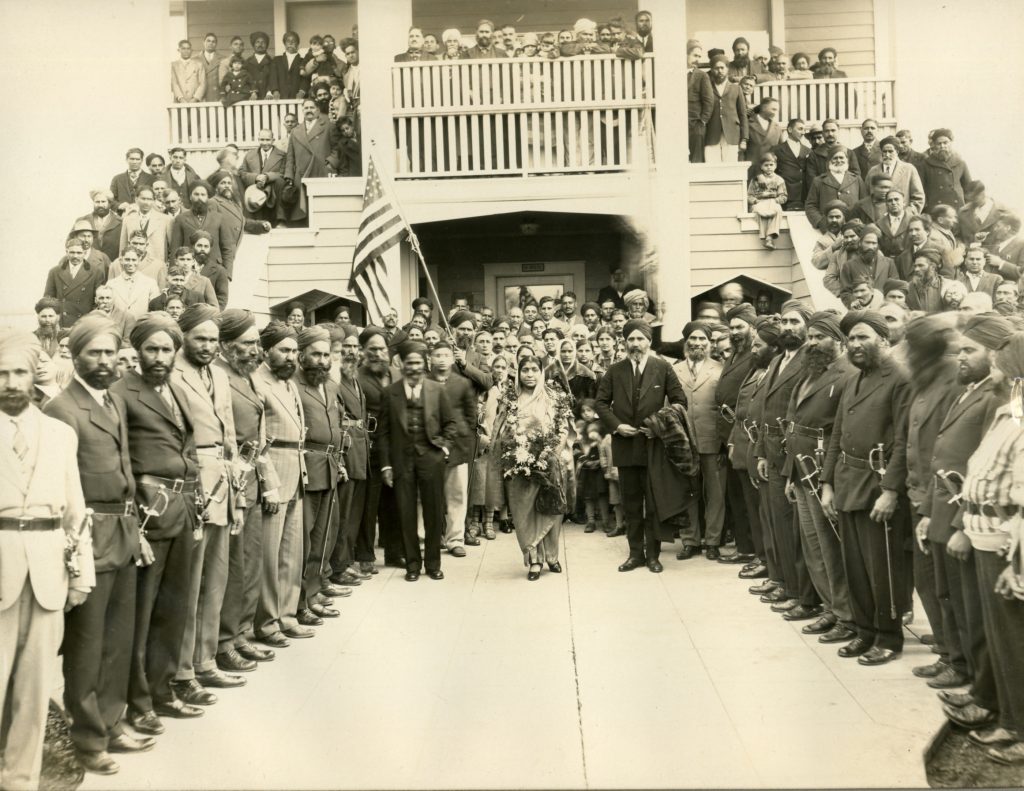
Stockton Sikh Gurdwara. Courtesy of the South Asians in North America Collection, Bancroft Library, UC Berkeley.

Gadar Press, Stockton Sikh Temple. Photograph by Nicole Ranganath
The Stockton Sikh Gurdwara was the first Sikh house of worship established in the United States. The temple has great historical significance as it formed the center of the religious, social and political life of the South Asian pioneers from 1912 until the 1960s and beyond. Before World War II/India’s Independence, the temple served Sikhs, Muslims, Hindus, and the Catholic wives and American-born children of the Punjabi pioneers.
The Stockton Gurdwara was founded by the Pacific Coast Khalsa Diwan Society in 1912. The two founders of the Gurdwara were Jawala Singh and Wasakha Singh. Known as the “Potato King” due to his success farming this crop, Jawala Singh served as the first granthi of the gurdwara, the first Vice President of the Gadar Party, and the president of a peasant union in the Punjab. Settling in the San Joaquin Valley, Jawala Singh and another Punjabi pioneer, Wasakha Singh, leased a 500 acre ranch in Holtville near Stockton. The Holtville farm included one room reserved for the Sri Guru Granth Sahib (Holy Book), and other Punjabi farmers would participate in prayers at this and other farms. The first Sikh congregational prayer in the United States was held on November 1, 1911 at Sardar Nand Singh’s camp near Stockton. The following year the congregation formed the Pacific Coast Khalsa Diwan Society with Sant Teja Singh as its President. In 2012, the society purchased the 1930 Grant Street lot in Stockton to build the first Gurdwara where the new wooden structure would be completed in 1915. In 1929, the Stockton Gurdwara was expanded and a new brick building was completed. The Stockton Sikh Temple is now a historical landmark of California.
The Stockton Gurdwara was also the hub for the social and political life of the South Asian pioneers. In 1912, Jawala Singh sponsored generous scholarships for students in India, including men and women from all religions, to attend UC Berkeley. For these students, he provided room and board in a house he purchased on Alston Way in Berkeley. The Stockton Gurdwara also became the center of activities for the revolutionary Gadar party. Jawala Singh played a crucial role in recruiting Punjabi farmworkers in California to return to India in 1914 to fight against the British government. Eventually, he and Wasakha Singh donated their farm to the Gadar party. Many Punjabi farmers helped finance the Gadar party activities, including the printing of a weekly newspaper in multiple languages; this publication has the distinction for being the first Punjabi language press in the United States. Today, the Gadar printing press resides in the Stockton Gurdwara. The Gurdwara also produced important leaders who made an impact in American politics. Dr Dalip Singh Saund, the first Asian American, Sikh American, and Indian American to serve in the US Congress, was the Secretary of the Stockton Gurdwara. The Stockton Gurdwara also served as the central social gathering place for South Asian pioneers who lived as far away as Arizona and southern California, and often the pioneers from across the West Coast would see each other a few times a year for special holidays and festivals at the Stockton Gurdwara.
SOURCES:
Bindra, Onkar Singh. “Baba Jawala Singh and Baba Wasakha Singh, Founding Fathers” in Sikh-American Establishments & Their Journeys, 1912-2012, Pacific Coast Khalsa Diwan Society, 40-42.
Mann, Gurinder Singh, Paul David Numrich and Raymond B Williams, Buddhists, Hindus and Sikhs in America (Oxford: Oxford University Press, 2001).
